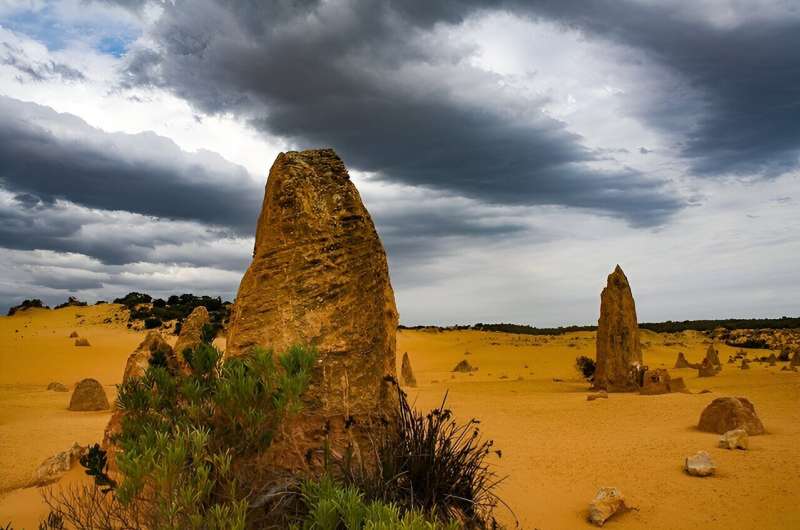This article has been reviewed according to Science X's editorial process and policies. Editors have highlighted the following attributes while ensuring the content's credibility:
fact-checked
trusted source
proofread
The pinnacles: Deep time, not termite mounds

On Yued Noongar country, 250km north of Perth, the Pinnacles have been standing quietly for 25,000 years. This vast network of stone columns, numbering in their thousands, is a popular tourist destination within Nambung National Park.
To visit the Pinnacles at sunset is to walk through an other-worldly landscape, among imposing spires casting lengthening shadows across dunes of coarse yellow sand.
While the rock formations may seem alien, they're the result of a unique combination of geological processes, flowing through the deep history of this ancient landscape.
Back in time
The Pleistocene epoch, from 2.5 million to 11,700 years ago, is characterized by a volatile climate. The earth cycled eight times between ice ages and warmer interglacial periods. On the Australian continent, this was the age of megafauna, punctuated by the arrival of humans some 60,000 years ago.
It's against this backdrop that the Tamala Limestone was formed—a continuous ribbon of rock cropping out along the West Australian coast between Shark Bay and Albany. The Pinnacles sit within and are composed of this outcropping.
The Tamala Limestone is made of compacted layers of quartz sand and shells. The inhabitants of these shells lived and died during the Pleistocene. During cold times, when sea levels receded, their tiny husks were picked up off dry seabeds, moving inland on the wind.
Time can turn coastal dunes to stone. The lime content in the shells dissolves in the rain and resolidifies as layers of sedimentary rock that divide time like a tree's rings mark seasons.
Creamy colored and dense, Tamala Limestone is a visible part of our city's architecture. It's quarried today for use in construction. Perth Mint and Fremantle Gaol are among the many public and residential structures built from generous, uniform blocks of the rock, carved out of deep time to build the present.
Super natural theories
The Pinnacles were not formed by aliens, and they're not termite mounds or petrified trees. We don't know why the Pinnacles were formed or why there aren't similar formations all the way along Noongar country.
In regions like Margaret River, the limestone has undergone a more typical process of karstification—the formation of caves. The mystery of the Pinnacles represents the challenge of discerning long, slow processes from physical forms observed at a precise moment in time.
Walking among the stone structures provides clues about their origins. Each pinnacle has unique dimensions, and in our human way, many have a name or a personality. There's huge, hollow columns and broader, tombstone-like mounds. They stand alone or together in groups like conferences of ghosts.
Up close, some display the distinctive textures of shells or petrified roots and branches. Some mushroom-shaped pinnacles have visible calcrete caps—the smoother, harder cement more resistant to erosion than the grainy limestone underneath.
Constant change
Diverse theories pose different stories of solidification and erosion, differing mainly in mechanisms and timelines. Each theory begins after the formation of the Tamala Limestone—at some point, somehow, parts of the rock became harder than others through the formation of cement-like calcrete. As the rock surrounding these hardened areas weathered away around 25,000 years ago, the Pinnacles were left standing.
Studies suggest that different shaped pinnacles are due to different reasons for the hardening—microbial, organic causes or complex interactions within the rock.
Though the Pinnacles are monuments to the long ago, the sands of the desert are still shifting, and the geological processes continue. As new formations emerge on the northern end of the park, the southernmost formations are being subsumed into the sand.
Provided by Particle
This article first appeared on Particle, a science news website based at Scitech, Perth, Australia. Read the original article.




















